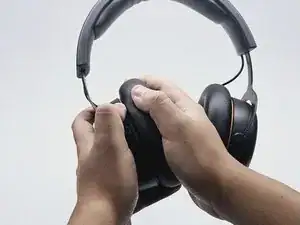
Beyerdynamic MMX100 Volume Controller Repair
These are some common tools used to work on this device. You might not need every tool for every procedure.
Headphones are electro-acoustic transducers for converting electric signals into sounds. More simply, headphones enable acoustic enjoyment of computers, media players, and home stereo systems, via cable, Bluetooth, or Wi-Fi.
Headphones as we know them originated from an adaptation of the telephone earpiece, with the first working set being developed in 1910 out of Nathaniel Balwin’s kitchen. These early headsets were uncomfortable, had poor sound quality, and in the case of early radio applications carried high voltages and posed a shock risk to their users. Then in 1958, when headphones had primarily been used by the government or professionals in the telephone/radio industry, John. C. Koss and Martin Lange developed the first stereo, high-fidelity headphones, the SP/3, as an afterthought from a failed attempt to develop a portable phonograph.
The portable earbud we’re familiar with was adapted from the hearing aid, and a lot of hardcore computing in the 60’s. It’s amazing, the transition another 60 years would bring to get us to the wireless earbuds we see today.
Headphones have had a fairly consistent design for much of their lifespan. If your device consists of two sound producing ear-cups joined by a band that sits over the top of the head, it’s likely a pair of headphones. Likewise, sound producing buds that sit in the ear canal, either with an audio cable or bluetooth capabilities are likely the earbud varietal of the headphone.
Headphones can be most readily classified by the manner in which they are positioned in reference to the ear of the user. Often a manufacturer's model number will be readily found on the exterior of headphones with larger earpieces such as over-ear models.
On-ear headphones are a style of headphones that sit on the outside of the ear as opposed to over-ear headphones which fully surround the ear or in-ear headphones which fit inside the ear. For technicality’s sake, this design is also known as the “supra-aural” style.
On-ear headphones are generally lighter and smaller than over-ear headphones; thus, they can be more comfortable as long as the sides do not press too hard on your ears. Some on-ear headphones have flat sides and others use small earcups—the cushy ring that sits on your ears—to add padding.
The most common issues with over-ear headphones come from the cables (unless you have wireless headphones of course) and the earpads. Cables get caught and yanked and usually break long before the body of the headphones. If you can’t hear sound from one or both of the sides of your headphones, try replacing the cable first. The earcups also wear out as they rub against our sweaty, oily ears. If you want to optimize for repair and make your money last, look for headphones with replaceable cables and earpads.
Tip: most products with headphone jacks require a 3.5mm (1/8 inch) headphone connector. Some professional gear uses 6.35mm (1/4 inch) connectors, but if you’re not sure, it’s probably 3.5mm.
Supra-Aural Headphones on Wikipedia
Phone connector on Wikipedia (for more information on 3.5mm vs. 6.35mm)
Types of headphones explained on Wire Realm
Over-ear headphones are headphones that encase the entire ear with the earmuff and speakers. Over ear headphones, also known as circumaural headphones, are used more frequently in a professional environment such as by audio engineers, recording artists and studios, and wireless communication. With the use of advanced bluetooth technology, wireless headphones have been the favorite of many recent consumers. In 2020, bluetooth headphones were the featured products in the audio section in the world’s largest consumer electronics trade show, Consumer Electronics Show (CES).
Over ear headphones can come in many different varieties. Open-back headphones allow sound to leak out of the speakers due to the open back of the earcups. Closed-back headphones block more ambient noise and can generally produce a wider range of sounds than open back headphones. Semi-open headphones are a hybrid of the open-back and closed-back headphones.
Wikipedia: Circumaural Headphones
In-ear headphones, also known in a multitude of names such as in-ear monitors (IEMs), earphones, earbuds, or canalphones, are small headphones inserted into the ear canal itself. In-ear headphones are preferred by users for its convenience and portability. Since in-ear headphones are designed to fit inside the ear canal, they naturally block out ambient noise. Unlike over-ear headphones, the main concern of using in-ear headphones is increasing the volume extremely high enough to cause hearing loss.
As with over-ear headphones, in-ear headphones have benefited from the advancements in bluetooth technology. Bluetooth in-ear headphones have become increasingly popular, especially with the introduction of the Apple AirPods in the fall of 2016. AirPods sales nearly doubled to $6 billion in 2019 compared to the previous year, and is set to become the third largest product division of Apple. With this recent surge of in-ear headphones sales, other popular earbuds and earphones include the Sony WF-1000XM3 Wireless Earbuds, Jabra Elite 75t, Sennheiser Momentum True Wireless, etc.
Wikipedia: Ear-Fitting Headphones
Amazon Best Sellers: In-Ear Headphones
TechRadar Best In-Ear Headphones in 2020
Wikipedia